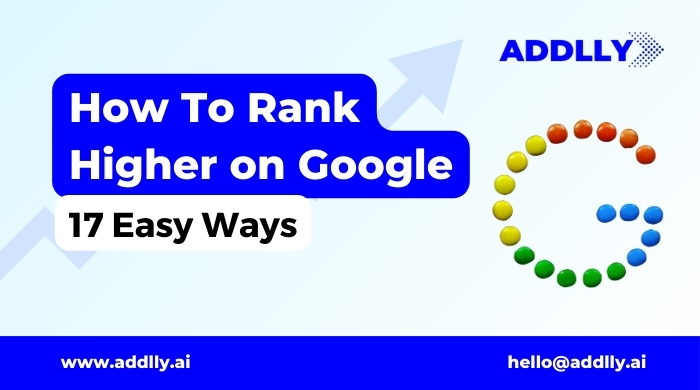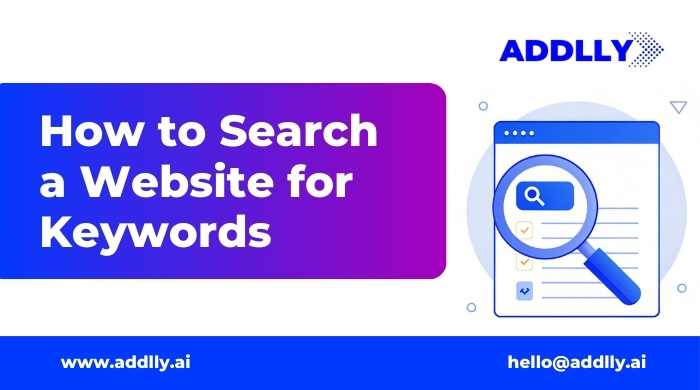Welcome to the ultimate guide on how to rank higher on Google. If you’ve ever wondered how to improve your website’s visibility, attract more organic traffic, and outshine your competitors, you’re in the right place.
In this comprehensive article, we will dive deep into 17 easy-to-implement strategies that will turbocharge your website’s performance on Google. Whether you’re a seasoned website owner looking to enhance your online presence or a newbie just starting your digital journey, these proven techniques will equip you with the tools and knowledge to rise through the ranks.
Quick Summary Powered by Addlly AI
Toggle1. Optimize Your Website’s Loading Speed

Website speed and mobile-friendliness are no longer optional but pivotal to SEO success. According to Google, if your website takes more than 3 seconds to load, around 53% of mobile users are likely to abandon it. Additionally, a 1-second delay in page load time can result in a 7% reduction in conversions.
To improve loading speed, consider compressing images, minifying code, and leveraging browser caching. Utilize tools like Google’s PageSpeed Insights or GTmetrix to identify speed bottlenecks and receive recommendations for optimization. A faster-loading website not only enhances user experience but also signals search engines that your website is efficient and reliable.
2. Relevant and High-Quality Content

Next, focus on creating relevant and high-quality content. Backlinko found that the average word count of a page that ranks on the first page of Google is 1,447 words.
To create this type of substantive content, you can leverage Addlly AI 1 Click Blog Writer. This allows you to dig deep into your topics and thoroughly explore them. The AI tool generates detailed, long-form content based on comprehensive keyword research and trending data.
By using the SEO Blog Co-Pilot, you can craft blogs that are not only informative and engaging, but also optimized for search engines. Google’s algorithms favor content that comprehensively addresses user queries and provides a wealth of relevant information.
3. Backlinks and Authority

Backlinks play a crucial role in establishing your website’s authority and ranking higher on Google. Backlinks are links from other websites back to your site, and search engines view them as votes of confidence. Building a strong backlink profile requires a strategic approach, such as guest posting on authoritative websites and participating in industry forums.
Additionally, social media platforms can be utilized to build backlinks and increase your website’s visibility. Sharing your high-quality content on social media encourages user clicks and the potential for natural backlinks. Engaging with influencers and industry leaders on social media can also lead to collaborative opportunities and valuable backlinks.
4. Building a Strong Online Presence

Establishing a robust online presence entails actively engaging with your audience across diverse digital channels, including social media platforms, industry forums, and online communities. By leveraging these channels, you can cultivate relationships, demonstrate your expertise, and even secure valuable backlinks. This multifaceted approach not only enhances your website’s visibility but also bolsters its credibility in the eyes of both users and search engines.
Engagement across digital platforms facilitates the dissemination of valuable content and fosters meaningful connections with your target audience. Through consistent interaction and contribution to relevant discussions, you not only showcase your authority but also position your brand as a trusted resource within your industry. Additionally, the accumulation of backlinks resulting from these interactions serves to further solidify your website’s authority and improve its ranking in search engine results.
5. Incorporate Relevant Keywords

Keywords are pivotal in SEO, with search engines now prioritizing semantic relevance and understanding context. Rather than stuffing content with exact-match keywords, it’s crucial to integrate related terms and synonyms naturally. This approach aids search engines in grasping your content’s topic while maintaining readability and enhancing user experience.
Recent studies underscore the importance of semantic relevance in SEO, emphasizing the need to incorporate related keywords and synonyms organically. By doing so, you not only signal relevance to search engines but also ensure your content remains engaging and accessible to your audience.
6. Create Compelling Headlines and Meta Descriptions

Optimizing your page’s headline and meta description is paramount for maximizing the impact of your content. Craft compelling headlines that not only incorporate relevant keywords but also accurately reflect the purpose and value proposition of your content. Recent data reveals that headlines incorporating numbers and power words tend to garner higher click-through rates, making them invaluable tools for driving engagement.
In addition to crafting attention-grabbing headlines, it’s essential to optimize your meta descriptions. These concise snippets provide users with a preview of your page’s content and play a crucial role in influencing click-through rates. By including relevant keywords and offering a succinct overview of what users can expect upon visiting your page, you can significantly increase the likelihood of capturing their interest. A captivating meta description not only entices users to click but also sends positive signals to search engines, ultimately contributing to improved SEO rankings.
7. Regularly Update and Refresh Your Content

Ensuring your content remains fresh and current is essential for maintaining strong SEO performance. Recent research underscores the significance of regularly updating content, as it can significantly enhance visibility and drive organic traffic growth. Incorporating new information, integrating recent statistics or case studies, and addressing any broken links are key strategies for keeping your content up-to-date. By consistently auditing and refreshing your content, you signal to search engines that your website is dynamic and relevant, ultimately bolstering your SEO ranking.
Moreover, regularly updating your content fosters user trust and engagement, as visitors are more likely to return to your site for the latest information. By demonstrating your commitment to providing accurate and timely content, you establish authority within your niche and cultivate a loyal audience base.
8. Implement Responsive Design for Mobile-friendliness

In today’s mobile-dominated world, the significance of having a mobile-friendly website cannot be overstated. With over half of all web traffic coming from mobile searches, ensuring your website is optimized for mobile devices is essential. Implementing a responsive design that automatically adjusts to various screen sizes and resolutions is crucial for providing a seamless user experience across different devices. Not only does responsive design enhance usability, but it also aligns with Google’s mobile-first indexing approach, where mobile versions of websites are given priority in search engine results. In essence, having a mobile-friendly website is no longer a choice but a prerequisite for achieving SEO success.
By prioritizing mobile optimization, you not only cater to the growing number of mobile users but also signal to search engines that your website is user-friendly and accessible across all devices. This, in turn, can lead to higher search engine rankings and increased visibility, ultimately driving more traffic to your site and contributing to your overall online success.
9. Optimize Images and Multimedia for Speed

Images and multimedia play a crucial role in enhancing the visual appeal of your website, yet they can also hinder performance if not optimized properly. Research reveals that nearly 40% of users will abandon a website if images take too long to load, highlighting the importance of optimization. To address this issue, it’s essential to compress images without compromising quality, implement lazy loading techniques to defer image loading until they’re visible, and consider responsive image solutions for delivering appropriately sized images based on the user’s device. By optimizing multimedia elements, you can achieve a harmonious balance between visual appeal and website speed, ensuring a positive user experience.
By prioritizing multimedia optimization, you not only enhance user engagement but also mitigate the risk of users abandoning your site due to slow load times. This proactive approach not only enhances user satisfaction but also positively impacts SEO, as faster-loading pages are favored by search engines, leading to improved rankings and increased visibility for your website.
10. Design for Smooth Navigation and User Experience

User experience (UX) is a cornerstone of effective SEO strategy, as evidenced by recent data indicating that a staggering 88% of users are unlikely to revisit a site following a poor experience. To optimize navigation and enhance UX, prioritize clear and intuitive menus, logical information architecture, and well-structured content on your website.
Incorporating features such as breadcrumbs and internal links aids in facilitating seamless navigation for users while simultaneously improving indexability for search engines. Moreover, conducting regular usability testing allows for the identification of areas requiring improvement, enabling ongoing refinement to elevate the overall user experience.
11. Monitor and Fine-tune Your Website’s Performance

Regularly monitoring your website’s speed, mobile-friendliness, and user experience is essential for maintaining optimal performance. Utilize tools like Google Analytics and Google Search Console to track important metrics such as bounce rate, average session duration, and pages per session. These insights provide valuable information about how users interact with your site, allowing you to pinpoint areas for improvement.
By proactively monitoring key performance indicators and making data-driven decisions, you can enhance user satisfaction and retention while simultaneously improving your site’s visibility and search engine rankings. This iterative approach to website optimization enables you to stay ahead of the curve and maintain a competitive edge in the digital landscape.
12. Claim and Update Your Business Information

When it comes to ranking higher on Google, one of the fundamental steps you need to take is claiming and updating your business information. This crucial process ensures that your business is accurately represented on the search engine, making it easier for potential customers to find you.
Claiming your business listing on Google and other search engines is vital for several reasons. Firstly, it allows you to have control over the information displayed about your business. By claiming your listing, you can ensure that all the essential details, such as your address, phone number, and business hours, are accurate and up to date. Moreover, claiming your business information improves your online visibility and credibility. When your business is correctly listed and verified, it appears more trustworthy to potential customers.
13. Get More Customer Reviews

In Google’s ranking algorithm, customer reviews have emerged as a critical factor, reflecting the search engine’s emphasis on fresh, relevant, and authentic content. Customer reviews serve as invaluable resources, offering insights into the quality and credibility of your business.
By providing real-time feedback and testimonials, reviews enable Google to gauge the relevance of your business to users’ search queries. This rich source of information not only enhances your visibility in search results but also establishes trust and credibility among potential customers, ultimately influencing your website’s ranking and online reputation.
14. Utilize Google Business Profile for Local Ranking

When it comes to ranking higher on Google, leveraging your Google Business Profile is of utmost importance, especially for local businesses. Your Google Business Profile serves as a powerful tool for optimizing your local presence and attracting potential customers.
An optimized Google Business Profile offers several advantages when it comes to local rankings. It helps you appear in local search results for relevant queries, ensuring that you reach your target audience in your specific geographical location. A study by BrightLocal revealed that 93% of consumers use search engines to find local businesses, highlighting the significance of local search visibility.
Moreover, an optimized Google Business Profile increases the likelihood that your business will appear in the highly coveted Google Local Pack, a prominent listing of local businesses shown on the search results page.
15. Keep up with Algorithm Changes

Google regularly updates its algorithms to ensure the most relevant and valuable content is presented to users. These updates can affect your website’s ranking and visibility, making it crucial to stay informed. By keeping up with algorithm changes, you can make necessary adjustments to your SEO strategies, ensuring that your website remains optimized and competitive.
One notable algorithm update is the Google Core Update, which brings significant changes to how search results are assessed. Understanding these updates and their implications can help you identify potential areas of improvement and align your website’s content and structure with Google’s updated ranking criteria.
16. Analyzing Competitor Strategies

Achieving higher rankings on Google requires a comprehensive understanding of your competitors’ strategies. By meticulously analyzing their approaches, you can unearth valuable insights, pinpoint areas of potential growth, and glean lessons from both their triumphs and setbacks. This strategic examination empowers you to fine-tune your own SEO tactics for optimal performance.
Moreover, staying vigilant about your competitors enables you to remain abreast of the evolving dynamics within your industry and the SEO methodologies that are proving effective, thereby equipping you with the knowledge and agility needed to adapt and thrive in the competitive digital landscape.
17. List Business Information in Directories and Links

Directories serve as online databases of businesses, making them an invaluable resource for users searching for specific products or services. By listing your business information in these directories, you increase the visibility of your business to potential customers, improving your chances of being found in relevant search results. Directories also provide valuable backlinks to your website, which signals to Google that your website is reputable and trustworthy.
Addlly AI – The Best AI SEO Tool to Rank Higher on Google

Addlly’s 1 Click Blog Writer is a powerful AI-powered content creation tool that allows you to generate high-quality, SEO-optimized blog posts with just a single click. By leveraging advanced language models like GPT-3.5, GPT-4, and Claude, the tool ensures your content is not only engaging and informative but also fully optimized for search engines.
The AI SEO Tool from Addlly takes your content optimization to the next level. With real-time keyword research, automated meta-tag generation, and integrated fact-checking capabilities, this AI-driven platform helps you create content that ranks higher on Google and other search engines. The tool’s advanced algorithms are regularly updated to incorporate the latest SEO best practices, ensuring your content stays relevant and competitive.
But Addlly’s offerings don’t stop there. The AI Social Media Post Generator empowers businesses to create captivating, shareable social media content that can boost engagement and drive more traffic to your website. By leveraging AI’s ability to analyze trends, target audiences, and craft compelling copy, this tool saves you time and effort while elevating your social media presence.
Whether you’re a small business, a marketing agency, or an enterprise-level organization, Addlly AI’s suite of tools can transform your digital marketing strategy and help you achieve unparalleled success in the search engine results pages (SERPs). Embrace the power of AI and take your online presence to new heights with Addlly AI.
Conclusion: The Future of Content Creation
Throughout this article, we have delved into various strategies and insights to help you improve your rankings on Google. By incorporating these techniques into your SEO efforts, you can increase your website’s visibility, attract more organic traffic, and ultimately grow your online presence.
However, it’s important to remember that SEO is an ongoing process. It requires constant monitoring, adaptation, and refinement. Consider the insights shared in this article as a foundation for your SEO strategies, but always remain open to testing new approaches and staying up to date with the latest industry developments.
Whether you are a business owner, marketer, or website owner, the quest to rank higher on Google is a dynamic journey. As you implement these strategies and insights, we encourage you to reflect on your progress, fine-tune your approaches, and continue to explore new opportunities to elevate your online presence and reach a wider audience.
Now it’s time to embark on your journey to higher rankings on Google. Wishing you success in your efforts to optimize your website and achieve your goals!
Recommend reads:
Author
-
As the Content Marketing Specialist at Addlly.ai, I specialize in writing compelling articles and creating visually engaging designs and videos for our marketing materials. My role encompasses developing informative and captivating content that resonates with our audience, alongside designing dynamic visuals that enhance our brand's message.
View all posts






